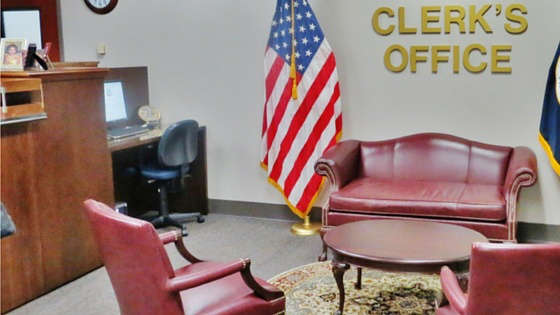In courthouses where electronic case filing (ECF) has been implemented, the once bustling clerk of court intake area has become a mere shadow of its former self – but not in a bad way. Can electronic case filing (ECF) similarly alter the clerk’s intake area in your courthouse?
I have previously posted about the impact of electronic case filing (EFC) on courthouse space including its impact on file room requirements in Space: The File Frontier – New Uses for your Vacant File Room, as well as its corresponding influence on the simplified open office design of private law offices in The Ruling Is in: High Tech Mobile Law Offices Really Work. A no less significant effect of electronic case filing (EFC) has been experienced in the clerk of court intake area. This is true for both space and staffing requirements.
Intake Area Space and Equipment
When I started courthouse planning years before the advent of electronic case filing (EFC), I often noted the insufficiency of queuing space and the resulting overcrowding in the clerk of court intake area. One or two clerk intake stations rarely seemed sufficient to handle the lines of attorneys, paralegals, and members of the public waiting to deliver or receive paper documents. Often, there was also a line waiting to use the sole copy machine in the intake area lobby.
During this period of active use of the clerk’s intake area, I also worked on revising standards in multiple court jurisdictions. These revisions inevitably included additional requirements for counter space, coin-operated copy machines, coin-operated fax machines, microform readers/printers, and queuing areas.
But implementation of electronic case filing (EFC) has eliminated the need for on-site paper processing equipment, while also reducing general space requirements due to the substantial reduction in the number of attorneys and paralegals that had previously come in person to the clerk’s office. Now, when I visit a clerk of court intake area that has implemented electronic case filing (EFC), I typically find a small, uncrowded lobby with one or two computer terminals for accessing public records. More often than not, the intake area is furnished with attractive, but rarely used seating that is placed there principally to provide a welcoming visual impression. Electronic case filing (EFC) has unquestionably reduced the pressure on clerk’s office space where it has been implemented.

Courthouse Public Access Computer Terminals
An excellent example of a clerk’s intake area that was simplified as a result of the implementation of ECF is the intake area in the Missouri courthouse shown below. The first plan depicts the size and content of the intake area prior to the use of ECF. The second plan shows how it was reduced in size and how equipment was eliminated following the use of ECF.

Intake Area Staffing
In the past, for a small court jurisdiction with a minimal volume of activity in the clerk’s office, the intake counter was staffed by one or two counter clerks serving either part-time or full-time in this capacity. This number increased to several full-time clerks for a larger court jurisdiction with a greater volume of activity.
Today, where electronic case filing (EFC) has been adopted, I seldom see a counter, either in a small or large clerk’s office staffed with any-full-time counter clerks. Most often, the clerk responsible for counter assistance sits at a nearby workstation behind the counter principally performing other responsibilities.
Most of the Clerk’s Office staff that I have spoken to following the implementation of ECF assured me that ECF has helped them immeasurably in addressing their staffing and workload responsibilities.
Something Gained, Something Lost - Electronic Case Filing
The implementation of electronic case filing (EFC) has resulted in significant improvements in efficiency and accuracy in the case filing and management process. This has reduced the work effort and support space requirements for both clerk’s office staff and private practitioners. It has also reduced the requirement for full-time counter clerks. These improvements would seem to have no downside.
Still, where electronic case filing (EFC) has not yet been adopted, I will occasionally watch a counter clerk smile when receiving a neatly organized set of documents from a well-known paralegal, and conversely watch as a counter clerk painfully accepts a disorganized set of documents that had just been hastily copied on the intake area copy machine.
That loss of human interaction, for better or worse, is just one more byproduct of the efficiencies created by the digital age.




.jpg)
.jpg)
.jpg)
.jpg)
.jpg)
.jpg)


-1.jpg)
.jpg)
.jpg)

